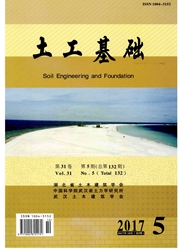

 中文摘要:
中文摘要:
对抗滑桩桩前存在开挖的情形进行了离心机振动台试验,输入的地震波为1940年5月18日加州Imperial Valley地震中在加州El Centro地区某个场地记录到的地面运动的南北分量,包括以相等的时间间隔为0.02秒的1559个数据点。由于振动台的峰值加速度不能精确控制,开挖时的最大加速度为0.38g。通过在模型桩上贴应变片的方式对抗滑桩的弯矩进行了量测,用激光测距仪对桩顶位移进行了监测。同时,通过埋设土压力计和加速度计,对桩前土压力和坡体不同标高的加速度进行了测量。模型制作时,桩底为固定。
 英文摘要:
英文摘要:
Currently,there is no published references of seismic centrifuge test results on the sliding resistance caissons under the excavation conditions.This paper presents the first seismic centrifugal testing result on this topic.The input of the seismic waves are the actual earthquake recorded on May 18,1940 Imperial Valley Earthquake at a site in El Centro,California.The input vibrations have a total of 1559 data points with a time interval of 0.02 seconds.The maximum acceleration duration the excavation was assumed to be 0.38 g due to the lacked of the recorded maximum acceleration value.The bending moments of the sliding resistance caisson were measured by the strain gages and the deformations at the top of caisson were measured by the laser distance measurement.The seismic earth pressure and the accelerations at different depths were also measured by the earth pressure cells and the accelerometers that were embedded in the soils.The bottom of the caissons in the centrifuge test were in the fixed condition.
 同期刊论文项目
同期刊论文项目
 同项目期刊论文
同项目期刊论文
 期刊信息
期刊信息
